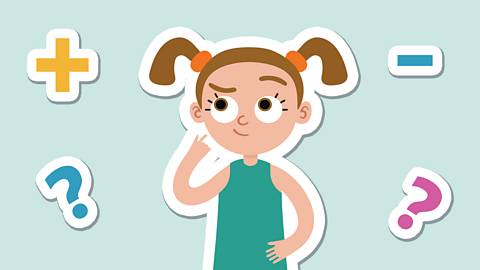Addition methods
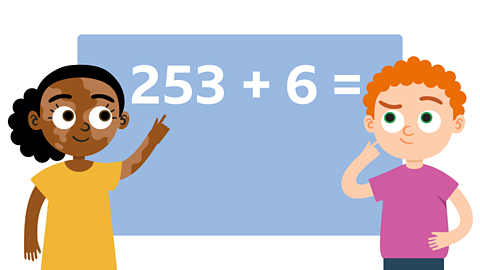
Addition involves finding the total of two or more numbers or amounts.
There are different things you can use to help you add. You can use number lines, place value charts and place value counters.
Knowing how to partition numbers and number bonds can make addition easier. It can even help you to work out the answer in your head.

Quiz: Adding 3-digit and 1-digit numbers together
Test out your knowledge of adding 3-digit and 1-digit numbers together with this quiz, then read on to complete the page.
Adding using hundreds, tens and ones
It's really helpful to understand hundreds, tens and ones when adding numbers together.
You can break down each number into its place values and add them separately.
Imagine you are adding 5 + 3. You might be able to work it out in your head.
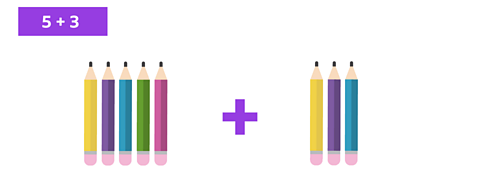
The answer is 8.
Now try adding 25 + 3.
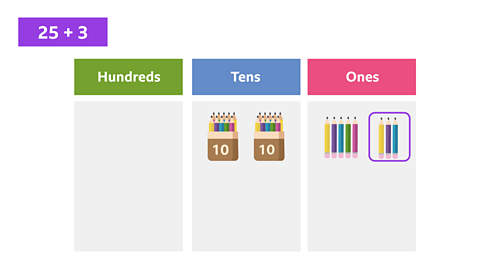
That’s two tens and 8 ones. The answer is 28.
If you already know that 5 + 3 = 8, then you also know that 25 + 3 = 28.
Now try adding 325 + 3.
This looks a bit tricker - but you can still work it out if you keep thinking about the hundreds, tens and ones.
In the number 325, there are 3 hundreds, 2 tens and 5 ones altogether.
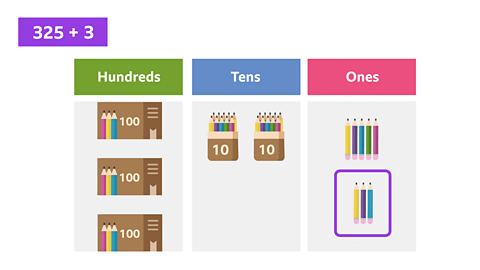
If you add 3 more ones the answer is 328.
If you already know that 5 + 3 = 8, then you know that 325 + 3 = 328.
With practice, breaking numbers down into hundreds, tens and ones can make addition easier.
Adding using place value counters
Using place value counters can help you visualise addition by showing how numbers combine in each place value.
To add using place value counters, put the counters into columns for hundreds, tens and ones to match the values of each number you’re adding.
Let's use some place value counters to solve 438 + 5.
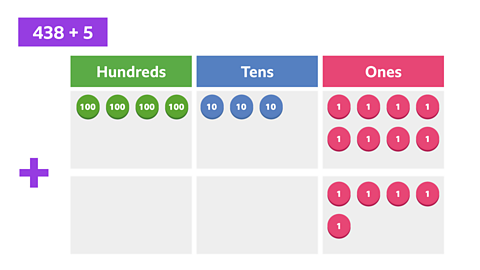
Image caption, The top row in this place value chart represents the number 438. The bottom row represents 5. How many ones are there?
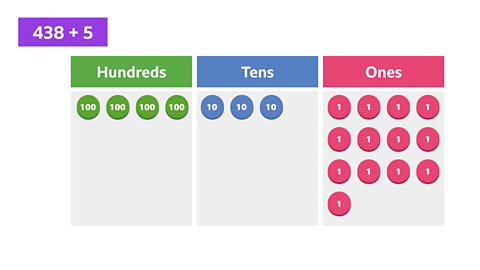
Image caption, There are 8 ones and 5 more ones. That's 13 ones altogether.
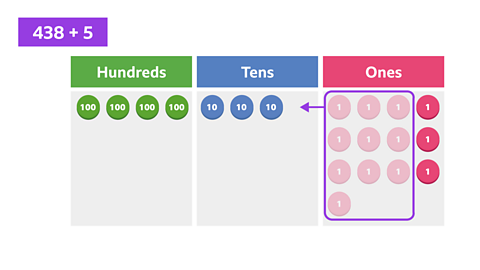
Image caption, 10 ones can be exchanged for 1 ten. After doing this, count the number of hundreds, tens and ones to work out the answer.
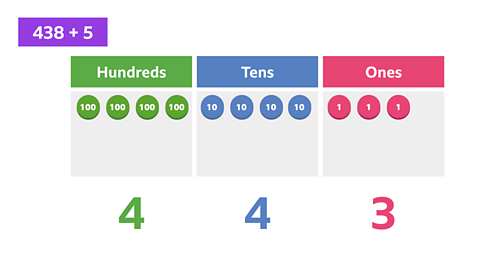
Image caption, The answer is 443. The 5 has been partitioned into 2 and 3 to make it easier to add.
1 of 4
Adding using a number line
Sometimes when you are adding a 1-digit number to a 3-digit number you have to bridge a ten. Bridging a 10 just means crossing over to the next ten.
This happens when the ones add up to more than 9.
Knowing your number bonds to 10 can really help with this.
Let’s see how to bridge across a ten using a number line:
What is 285 + 6?
You could work out the answer by making 6 jumps of 1 along the number line.

Or you could break up the number 6 into 5 and 1.
285 + 5 gets you to 290, which is the next ten.
Now, you only need to add 1 more to reach the final answer.
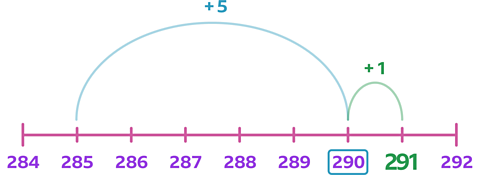
So, 285 + 6 = 291.
You can use a number line to see each step clearly, breaking it down into two smaller jumps.
With practice, you might even be able to do this in your head.
Example 1
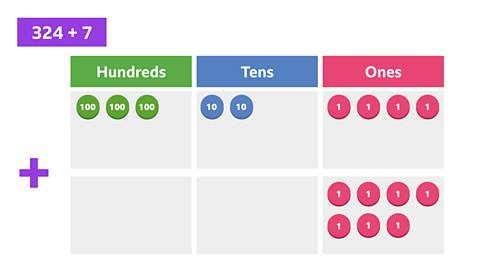
Use the place value table above to help you work out the answer to 324 + 7.
✓ The answer is 331.

Image caption, To work it out remember to first look at how many ones there are.
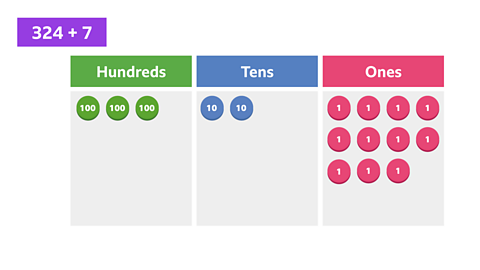
Image caption, There are 4 and 7 ones. This is 11 ones in total.
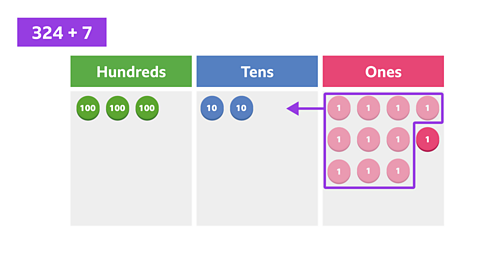
Image caption, Ten ones can be exchanged for one ten.
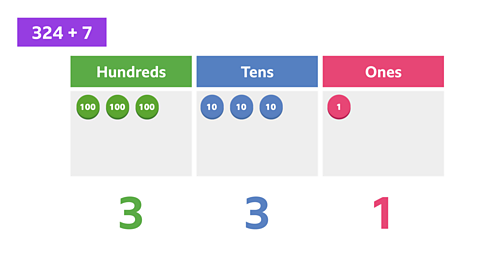
Image caption, Then it is easier to work out the answer which is 331.
1 of 4
Example 2

Use your knowledge of partitioning to solve the number sentence 555 + 7.
✓ 555 + 7 = 562

Did you partition 7 into 5 and 2 to help you bridge across the ten?

Example 3
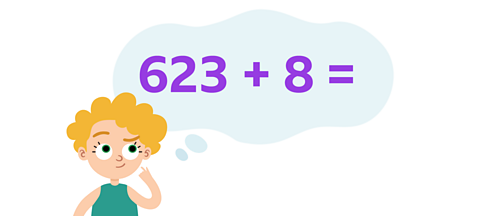
Add 623 and 8 together in your head.
Partitioning 8 will help you.
✓ The answer is 631.
You can partition 8 into 7 and 1.
3 + 7 = 10 which helps you to jump to the next multiple of ten.
Then you just need to add 1 more.
623 + 8 = 631
Play Guardians: Defenders of Mathematica to get ready for SATs. gamePlay Guardians: Defenders of Mathematica to get ready for SATs.
In this game, use the times tables and more maths skills to defeat monsters and reclaim the Kingdom.

More on Adding and subtracting
Find out more by working through a topic
- count4 of 12
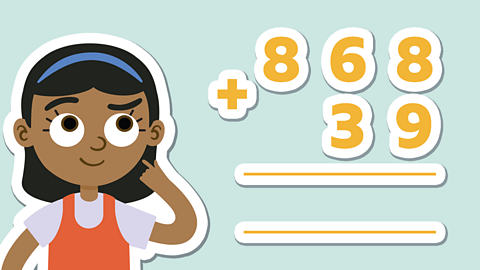
- count5 of 12
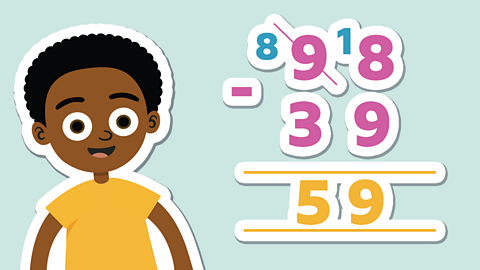
- count6 of 12

- count7 of 12
